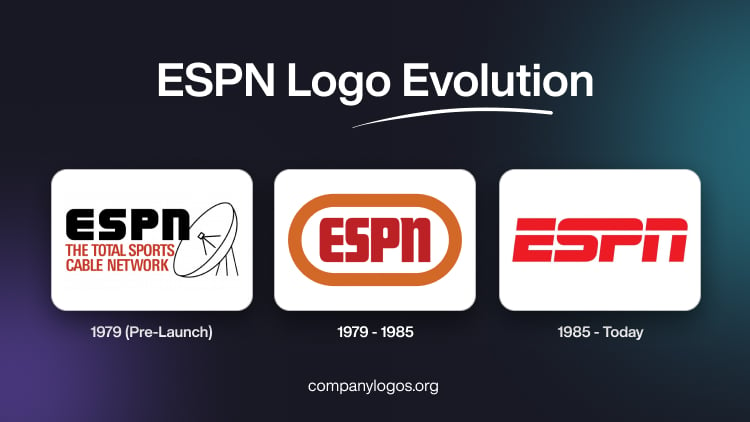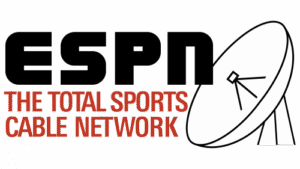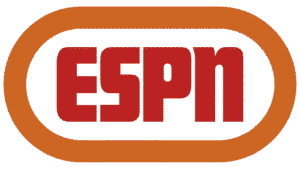
ESPN, or Entertainment and Sports Programming Network, is a US-based sports broadcasting company owned by the Walt Disney Company and Hearst Corporation. It was founded in 1978 by Bill Rasmussen, Scott Rasmussen, and Ed Eagan. The ESPN logo is one of the most recognisable emblems in sports broadcasting. It symbolises energy, excitement, and the network’s commitment to delivering world-class sports content. Its evolution from inception to the present day reflects the latest design trends and ESPN’s own growth as a global brand. The article delves into the evolution of the ESPN logo, among other details, about the network.
The Genesis of the ESPN Logo (1979) (Pre-Launch)
The pre-launch visual identifier of ESPN symbolised the promise the network made with respect to 24-hour sports coverage. The central part of the logo was the acronym “ESPN” in black, bold, uppercase, written using a sleek and slightly angular sans-serif typeface. The typeface highlighted the seriousness and professionalism of the network and established itself as the first sports network in the world that broadcasts round-the-clock.
The black colour of the wordmark represented confidence and authority, and the image of a satellite dish showed how cutting-edge technology is behind the broadcast. Beneath the acronym appeared the tagline “THE TOTAL SPORTS CABLE NETWORK” in red uppercase. It conveyed the core message of the brand being a comprehensive sports network.

(1979 – 1985)
The first ESPN logo featured the acronym “ESPN” in a muted red colour scheme set against a white background. It was encased within a thick orange border or oval. The colour choices were intentional. For instance, red symbolised passion and power, while orange was chosen for its psychological impact. These evoked excitement and anticipation, qualities ESPN wanted viewers to associate with sports.
The design itself was minimalistic, and it used bold uppercase letters in a straightforward, modern sans-serif font. The thick orange outline of the oval provided contrast and helped the logo stand out on screen. This logo was not just a visual identifier but a statement of ESPN’s intent to be a dynamic force in sports media.

(1985 – Today)
In 1985, ESPN introduced the logo that would become its enduring visual identity. This redesign marked a dramatic shift from the original, both in typography and overall style. The new logo, crafted with the Stop font designed by Aldo Novarese, featured bold, red letters slightly slanted to the right. It suggested forward momentum and progress, qualities that are synonymous with sports.
The most distinctive addition was a sweeping white line that cut horizontally through the upper part of the letters. This element was more than decorative, for it conveyed motion, speed, and the excitement of live sports action. At the same time, it also unified the acronym visually. The redesign eliminated the orange border and embraced a cleaner and more modern look that could adapt easily to various media formats.

The Elements of the ESPN Logo
Font
The latest ESPN logo is inspired by Stop, a typeface designed by Aldo Novarese, in 1971. The logo was built based on the white stroke on the letter “E”. The white stroke was continued to cover the rest of the letters. Besides, the glyphs were modified to fit into the new logo design. The typeface used in the logo is characterised by dynamism and modernity.
Colour
The colour palette used by the ESPN logo comprises a bright shade of red and white. The red colour draws the attention of the audience to attributes such as passion, strength, and intensity. The white colour, on the other hand, refers to perfection and purity.
The History of ESPN
ESPN, which stands for Entertainment and Sports Programming Network, was conceived in 1978 by Bill Rasmussen, his son Scott Rasmussen, and Ed Eagan after Bill was fired from his role with the New England Whalers hockey team. The original idea was to create a cable network focused on sports in Connecticut.
However, the team soon realised that leasing 24-hour satellite time was more cost-effective than limited hours. This led to a shift to a national, all-sports network. It secured crucial early funding from Getty Oil, which purchased a majority stake in early 1979. Getty Oil also entered into a major advertising deal with Anheuser-Busch.
ESPN was officially launched on September 7, 1979, and it broadcast to 1.4 million cable subscribers with its flagship program, SportsCenter. The network initially filled its schedule with a wide variety of sports, including college football and basketball, slow-pitch softball, and boxing. It often replayed events to fill airtime. By the end of 1983, ESPN had become the largest cable network in the United States and reached 28.5 million households.
In 1984, ABC, Inc. acquired a controlling interest in ESPN, thereby providing financial stability and enabling rapid growth. In 1987, ESPN secured its first NFL broadcasting contract, wherein it launched Sunday Night Football and marked a significant breakthrough into major professional sports. In 1992, ESPN Radio was launched, which expanded the brand into sports talk and live event radio coverage. In 1993, ESPN2 was launched by targeting a younger demographic. It quickly became one of the fastest-growing cable channels.
In 1983, ESPN began distributing sports programming outside the U.S. and formed ESPN International in 1988. It eventually broadcast regional sports like cricket in India and soccer in Latin America. In 1985, Capital Cities Communications acquired ABC, and with it, ESPN as well. In 1996, The Walt Disney Company purchased Capital Cities/ABC, thereby making Disney the majority owner of ESPN. Hearst Communications held a minority stake.
In the 1990s and 2000s, ESPN diversified with new channels (ESPNEWS, ESPN Classic), a magazine, and a website. With these, the network established its position as the “Worldwide Leader in Sports”. The network reached a peak of over 100 million subscribers in 2011, though it faced new challenges in the 2010s, such as rising broadcast costs and changing media consumption habits. These circumstances led to the launch of ESPN+, a direct-to-consumer streaming service, in 2018.
Interesting Facts About ESPN
- The headquarters of ESPN is in Bristol, Connecticut, on land that was once a dump. The founders chose this location because local ordinances prohibit satellite dishes, but Bristol allowed them. The land cost just $18,000, and the satellite signal was unaffected by the site’s history.
- The founders of ESPN initially planned a regional Connecticut sports channel, but after learning that a 24-hour satellite feed was cheaper than local landlines, they switched to a national model. This early adoption of satellite technology allowed ESPN to reach a nationwide audience from day one.
- On September 7, 1979, only about 30,000 viewers tuned in for ESPN’s launch. The first words spoken on air were, “If you’re a fan, what you’ll see in the next minutes, hours, and days to follow may convince you you’ve gone to sports heaven.” The first SportsCenter highlight was Chris Evert’s win over Billie Jean King at the US Open.
- When pitching their idea, the founders faced scepticism from cable operators and the press. At their first press conference, only four reporters showed up, and the future of the channel seemed doubtful.
- Getty Oil purchased an 85% stake in ESPN before the network launched and received crucial funding. Anheuser-Busch also signed on as the exclusive beer advertiser with a $1 million deal. It helped establish ESPN as a credible television broadcaster with other sponsors and partners.
- The network’s name stands for “Entertainment and Sports Programming Network”. It was later shortened to just ESPN, but the original meaning reflects its broad ambitions from the start.
- SportsCenter, the flagship show of ESPN, started during the night of the launch and has aired continuously ever since. It quickly became a staple for sports fans, offering highlights, news, and analysis around the clock.
- ESPN was the first network to televise the NFL draft (starting in 1980) and turned it into a major television event. It also started 24-hour sports coverage, which was a radical idea at the time.
- By the mid-1980s, ESPN had become one of the largest cable networks in the U.S. Its success led to the launch of sister channels like ESPN2, ESPNEWS, and ESPN Classic, as well as international networks.
- ESPN International began distributing sports programming outside the U.S. in 1983. It eventually broadcast regional favourites like cricket in India and soccer in Latin America. Today, ESPN operates channels in Africa, Australia, Latin America, and the Netherlands.
- ESPN was acquired by ABC in 1984, then by Capital Cities/ABC in 1985, and finally by The Walt Disney Company in 1996. Disney now owns 80% of ESPN, with Hearst Communications holding the remaining 20%.
- ESPN signed a $400 million contract in 1990 to broadcast Major League Baseball, which marked one of the largest sports rights deals at the time. It also secured rights to NFL games in 1987, which helped transform the network into a sports broadcasting powerhouse.
- The first ESPY Awards, ESPN’s annual sports award show, started in 1993. It celebrated athletic achievement and sports culture.
- Beyond television, ESPN has expanded into radio, digital media, publishing (ESPN The Magazine), and even themed restaurants.
Finally
The ESPN logo and the one change that it has undergone since its inception show the rise of the network from a cable startup to a global sports powerhouse. Its design choices, such as minimalism, bold colour, and dynamic typography, have helped it remain fresh and relevant for decades. The logo’s enduring appeal lies in its ability to communicate energy, excitement, and trustworthiness at a glance. This makes the logo a masterclass in effective brand identity design.